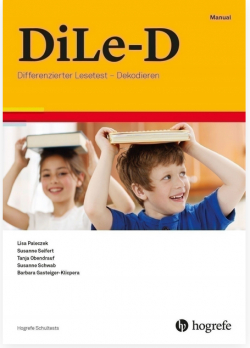DiLe-D - Differenzierter Lesetest - Dekodieren (de)

Book Stores
Type
Book
Category
Publication Year
2017
Publisher
Hogrefe, Germany
Abstract
The DiLe-D is used for the differentiated diagnosis of reading skills. The procedure measures the decoding ability on a lexical and non-lexical level. Thus, deficits in both phonetic reading and direct word recognition can be identified.
Description
It is aimed at children in grades 1 to 3 of elementary school. The procedure can be used at the end of the 1st grade school year (last 6 weeks) as well as at the beginning and end of the 2nd and 3rd grade school year (first and last 6 weeks respectively). Both children with German as their first language (L1 German) and children with German as their second language (L2 German) can be examined in individual settings.
The procedure comprises two subtests. The word subtest consists of a list of 157 words and measures decoding ability at the lexical level. The Pseudoword subtest consists of a list of 157 pseudowords and measures decoding ability at the non-lexical level. The children are instructed to read aloud line by line from the word or pseudoword list for one minute each. In the evaluation, norm values are determined for the two subtests as well as for an overall value for decoding ability. The overall score allows a general statement to be made about the child's decoding abilities.
The procedure comprises two subtests. The word subtest consists of a list of 157 words and measures decoding ability at the lexical level. The Pseudoword subtest consists of a list of 157 pseudowords and measures decoding ability at the non-lexical level. The children are instructed to read aloud line by line from the word or pseudoword list for one minute each. In the evaluation, norm values are determined for the two subtests as well as for an overall value for decoding ability. The overall score allows a general statement to be made about the child's decoding abilities.
Number of Copies
1
| Library | Accession No | Call No | Copy No | Edition | Location | Availability |
|---|---|---|---|---|---|---|
| Main | 925 |
30008630 |
1 | Yes |